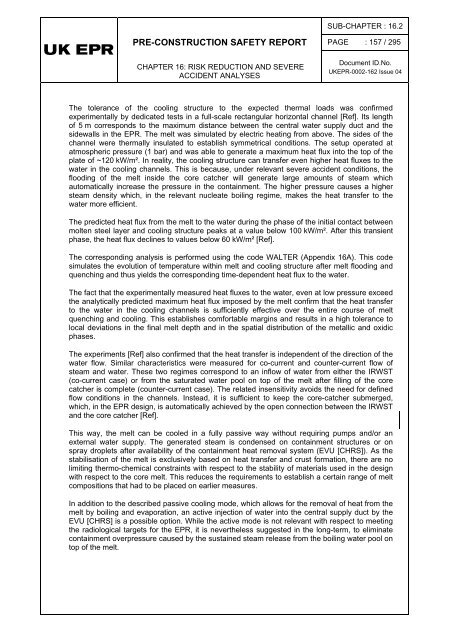16.2 - Severe Accident Analysis (RRC-B) - EDF Hinkley Point
16.2 - Severe Accident Analysis (RRC-B) - EDF Hinkley Point
16.2 - Severe Accident Analysis (RRC-B) - EDF Hinkley Point
You also want an ePaper? Increase the reach of your titles
YUMPU automatically turns print PDFs into web optimized ePapers that Google loves.
SUB-CHAPTER : <strong>16.2</strong>PRE-CONSTRUCTION SAFETY REPORTCHAPTER 16: RISK REDUCTION AND SEVEREACCIDENT ANALYSESPAGE : 157 / 295Document ID.No.UKEPR-0002-162 Issue 04The tolerance of the cooling structure to the expected thermal loads was confirmedexperimentally by dedicated tests in a full-scale rectangular horizontal channel [Ref]. Its lengthof 5 m corresponds to the maximum distance between the central water supply duct and thesidewalls in the EPR. The melt was simulated by electric heating from above. The sides of thechannel were thermally insulated to establish symmetrical conditions. The setup operated atatmospheric pressure (1 bar) and was able to generate a maximum heat flux into the top of theplate of ~120 kW/m². In reality, the cooling structure can transfer even higher heat fluxes to thewater in the cooling channels. This is because, under relevant severe accident conditions, theflooding of the melt inside the core catcher will generate large amounts of steam whichautomatically increase the pressure in the containment. The higher pressure causes a highersteam density which, in the relevant nucleate boiling regime, makes the heat transfer to thewater more efficient.The predicted heat flux from the melt to the water during the phase of the initial contact betweenmolten steel layer and cooling structure peaks at a value below 100 kW/m². After this transientphase, the heat flux declines to values below 60 kW/m² [Ref].The corresponding analysis is performed using the code WALTER (Appendix 16A). This codesimulates the evolution of temperature within melt and cooling structure after melt flooding andquenching and thus yields the corresponding time-dependent heat flux to the water.The fact that the experimentally measured heat fluxes to the water, even at low pressure exceedthe analytically predicted maximum heat flux imposed by the melt confirm that the heat transferto the water in the cooling channels is sufficiently effective over the entire course of meltquenching and cooling. This establishes comfortable margins and results in a high tolerance tolocal deviations in the final melt depth and in the spatial distribution of the metallic and oxidicphases.The experiments [Ref] also confirmed that the heat transfer is independent of the direction of thewater flow. Similar characteristics were measured for co-current and counter-current flow ofsteam and water. These two regimes correspond to an inflow of water from either the IRWST(co-current case) or from the saturated water pool on top of the melt after filling of the corecatcher is complete (counter-current case). The related insensitivity avoids the need for definedflow conditions in the channels. Instead, it is sufficient to keep the core-catcher submerged,which, in the EPR design, is automatically achieved by the open connection between the IRWSTand the core catcher [Ref].This way, the melt can be cooled in a fully passive way without requiring pumps and/or anexternal water supply. The generated steam is condensed on containment structures or onspray droplets after availability of the containment heat removal system (EVU [CHRS]). As thestabilisation of the melt is exclusively based on heat transfer and crust formation, there are nolimiting thermo-chemical constraints with respect to the stability of materials used in the designwith respect to the core melt. This reduces the requirements to establish a certain range of meltcompositions that had to be placed on earlier measures.In addition to the described passive cooling mode, which allows for the removal of heat from themelt by boiling and evaporation, an active injection of water into the central supply duct by theEVU [CHRS] is a possible option. While the active mode is not relevant with respect to meetingthe radiological targets for the EPR, it is nevertheless suggested in the long-term, to eliminatecontainment overpressure caused by the sustained steam release from the boiling water pool ontop of the melt.













![6.3 - Safety Injection System (RIS [SIS]) - EDF Hinkley Point](https://img.yumpu.com/42739985/1/184x260/63-safety-injection-system-ris-sis-edf-hinkley-point.jpg?quality=85)


